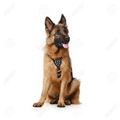
| |
| Boxer dog |
| Boxer dog -An Introduction to the Boxer >>> Congratulations! You are now sharing your life with a Boxer he wouldn't have it any other way! The Boxer's most notable characteristic is his desire for human affection. Though his spirited bearing, square jaw, and cleanly muscled body suggest the well-conditioned middleweight athlete of dogdom, the Boxer is happiest when he is with peopleespecially children. He is truly a "dog for all seasons," suiting the need for household guardian, attractive companion, playmate, and loyal friend. >> History >>>The Boxer's origins are ancient, dating back as far as 2500 BC. But it was Germany in the 19th century that refined and developed the breed as we know it today. The Boxer was used on the ducal estates to run down and hold large, fierce game—wild boar, bear and bison - until the human hunter could approach and dispatch the quarry. To that end, the Boxer was bred to be a powerful, muscular dog with the wide undershot jaw for maximum holding power. Though he is not used any longer for such pursuits, the Boxer of today should be able to perform the duties for which he was bred >>> Beauty and Brains >>> The Boxer is a hearing guard dog, ever alert to protect his family but tolerant of any stranger once he knows there is no danger. He is a happy, exuberant dog who delights in children and is eager to play long after he has left puppyhood behind. The mood-mirroring quality of his expression and his overall sweet nature have endeared him to generations of Boxer owners. He is a natural show-off, and many Boxers excel at Conformation, Agility, and Obedience events held in conjunction with AKC shows. The well trained Boxer is a glorious sight to behold. The Boxer is a medium sized dog ranging from 21½" in height for a smaller female to 25" and sometimes more for a taller male. Adult weight may reach 65-80 lbs. in the male with the females about 15 lbs. less. There are no giant or miniature varieties. The short, close-lying coat comes in two equally acceptable colors—fawn and brindle. The fawn may vary from a tawny tan to a stag red. The brindle ranges from sparse, but clearly defined black stripes on a fawn background to such a heavy concentration of black striping that the essential fawn background color barely, although clearly, shows through—creating the appearance of "reverse" brindling. White markings should be of such distribution to enhance the dog's appearance, but may not exceed 1/3 of the entire coat. It is not uncommon to have an entirely white Boxer born in a litter, or one with predominately white background known as a "check." In order to retain the beauty of the fawn and brindle colors, the American Boxer Club members are pledged not to use these "whites" for breeding. They may not compete in Conformation classes but are eligible for Performance events >>> Care of Your Boxer >>>> The Boxer requires relatively little grooming, but ownership of any dog is a definite responsibility. HE MUST NOT BE ALLOWED TO RUN LOOSE. Exercise within a fenced area or on a leash will be adequate. Death from automobiles, poisons, or other hazards await the Boxer who is allowed to roam. While he is learning to be a responsible member of the household, especially while still a puppy, a crate is very advisable. It will protect him from household temptations and dangers while you are away. In addition, it is a great aid in housebreaking—your Boxer will rarely soil his crate. Be sure to use a collar with care. They can and do snag on the most unlikely objects with tragic consequences. Your Boxer should not be left alone with a collar around his neck—or while playing with canine friends. The Boxer has a natural tendency to keep himself clean, but it is the owner's responsibility to keep his nails trimmed to a reasonable length, and to keep his teeth clean as he ages. An occasional bath and/or currycombing should be all that he requires. You should feed your Boxer a good quality (usually kibbled) dog food. These are often found at feed or specialty stores. Most breeders recommend soaking the food in warm water as opposed to feeding it dry. Mixing it with a small amount of canned food is always enjoyable to your dog. Remember that the Boxer is a relatively fast-growing dog, and should not need supplementation with vitamins or calcium as he grows. Over supplementation can cause bone and joint problems. Always speak to your veterinarian if in doubt. |
| ادامه مطلب : |
| تعداد نمایش : 2298 |
Dog , Buy Dog , Dealing Dog , Pet Shop , Animals , Pet , Pets Online , Dog Training , Dog breeding , Afghan dog , Boxer dog , Belgian Sheepdog , Bloodhound dog , Dalmatian dog , English Setter dog , Mastiff dog , PARSON RUSSELL TERRIER dog , Saint Bernard dog , Airedale Terrier dog , Basenji dog , Black and Tan Coonhound dog , Bull Terrier Puppy dog , Doberman Pinscher Puppy dog , Italian Greyhound dog , Neapolitan Mastiff dog , Rhodesian Ridgeback dog , Shiba Inu dog , , |